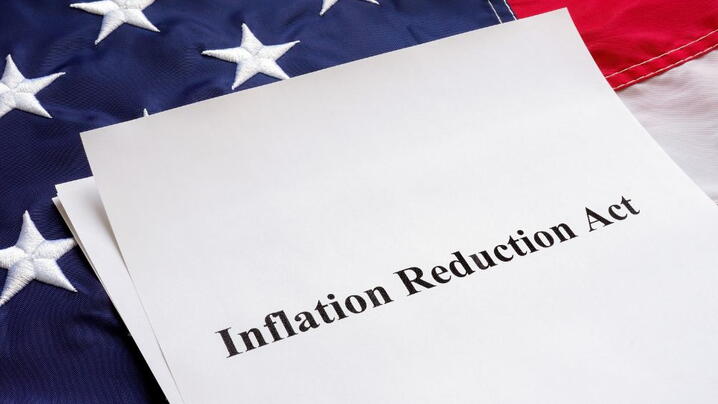
Sponsored content powered by Ameresco
Three major areas are key to meeting our country’s clean energy goals: technology, finance, and policy. The three are interdependent and inform one another, but the linchpin for all of them is policy. Strong, consistent clean energy policy creates the supportive environment that is necessary to spur technology and finance innovation.
While the pace of clean energy deployment is accelerating, it has been hampered by inconsistent policies and the lack of policy certainty. But new developments, including incentives for microgrids, could change the course of clean energy policy in the United States.
The Importance of Tax Credits
The recently passed Inflation Reduction Act of 2022 (IRA) is the most timely and pertinent policy available to accelerate the clean energy transition. Prior to the IRA being signed into law, the United States was only expected to reduce greenhouse gas emissions 17–25% by 2030, according to the Rhodium Group. A recent Princeton-led study estimates that the IRA could lead to a 42% emissions reduction in that same timeframe.
The IRA promotes the clean energy transformation in large part by expanding and providing policy certainty for tax credits, which are one of the main incentives for clean energy in the United States. The Investment Tax Credit (ITC) was previously scheduled to phase down, and prior extensions were typically made for only short time windows. The IRA reverses this trajectory, providing 10 years of tax credit certainty at the original ITC rate of 30%. Various adders can even increase the ITC to as much as 70% depending on the project location and whether it uses domestic content.
The IRA extends the ITC to for the first time cover standalone energy storage and microgrid controllers. By some estimates, changes like these could result in microgrid costs decreasing by 10% – 50%. The legislation also extends the Production Tax Credit (PTC) and expands its eligibility to once again include solar projects, creating a potentially lucrative opportunity for the solar industry.
After 2024, the IRA expands the ITC and PTC to apply to any zero-emissions electricity production. This should allow more companies to adopt a technology-agnostic approach. Being able to use whatever clean energy technology — such as microgrids, storage, solar, and biogas — allows developers to be nimble and flexible in the face of changing economics, customer needs, and policies.
A major missed opportunity in the IRA was its lack of a 100% direct pay option, a mechanism that allows an entity to claim a tax credit as a rebate, which would have streamlined project deployment and opened up the incentive to many more entities by allowing the tax credit to be claimed as a rebate. However, a limited version of direct pay has been added for tax-exempt entities such as state and local governments, public schools and universities, tribes, and rural electric cooperatives, providing them a new tool to fund clean energy projects. The IRA also allows an entity with a limited tax liability to transfer the value of the tax credit to a corporate partner who can monetize the credit, expanding the universe of potential funding partners.
Implementing and Supporting Clean Energy Policy
While focus in recent months has been on federal legislation, policy at the state and local level always remains critical. States like California, Illinois, Massachusetts, New York, and Hawaii have been setting aggressive clean energy policy standards, driving progress and complementing action at the federal level.
If the IRA does get the United States to around 40% emissions reductions by 2030, as projected, we’ll still be 10 percentage points short of the 50% reduction needed to comply with our Paris climate agreement target. With entrepreneurial efforts and supportive policies, states and the private sector can help us close that 10% gap.
While financing should be easier with the new federal policy, other obstacles remain that could slow clean energy deployment. Currently, the United States has a significant backlog of clean energy projects, which can get stuck in interconnection queues for years. The IRA provides some ability to include interconnection costs as part of the investment tax credit. This is helpful, but we still need to clear out existing backlogs and get projects online as quickly as possible, especially given that the queues could grow exponentially with the new projects that will be spurred by the IRA.
One ongoing issue will be ensuring that state, regional, and federal agencies have the staff in place to conduct interconnection studies and permit the many new projects that will be coming across their desks. The IRA includes some funding to help address this; additional investments will also be needed. In addition to the challenges of staffing agencies, adequately staffing the solar and energy storage workforce that the IRA will finance is going to be a serious challenge. Staffing is also an issue at the more local level. An energy manager for a school district, for example, has to focus on keeping the facility running and may not have the staff to aggressively pursue clean energy projects.
We must all continue working at the federal, state, and local level to push the industry forward and create a positive policy environment. Working together and with groups like Think Microgrid, American Clean Power Association, and the Solar Energy Industries Association, we can help drive the policies that will unleash the clean energy deployment we need to meet our climate goals.
For more information on leveraging an IRA see this quick reference sheet; or contact Ameresco.
New, Reduced Membership Dues
A new, reduced dues rate is available for CAOs/ACAOs, along with additional discounts for those in smaller communities, has been implemented. Learn more and be sure to join or renew today!
